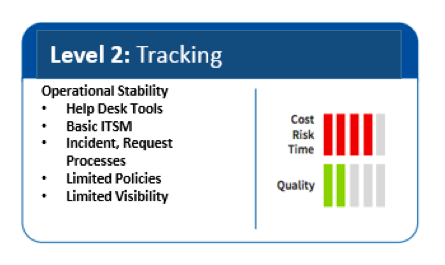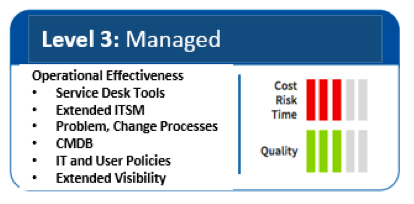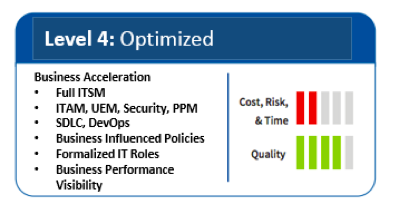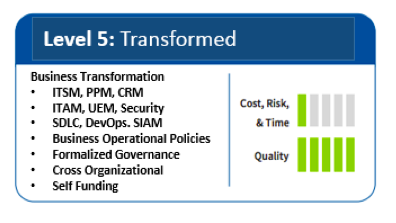The IT Service Management Attainment Model: An ITIL Roadmap for Continual Improvement
I love a catchphrase attributed to the people of rural Maine in the U.S. when replying to tourists asking for directions—often to places not reachable by a direct route: “Oh, that’s too bad. You can’t get there from here.”
When it comes to delivering reliable, real-world IT Service Management to your organization, can you get there from where you are now? Is your ITIL path well marked?
Ivanti suggests a roadmap for continual improvement—the IT Service Management (ITSM) Attainment Model. The model can help you understand your organization’s current level of attainment, with next steps and specific goals in order to transition from a reactive and turbulent state to one that’s is more proactive, managed, and strategic—and more valued the business overall.
And this roadmap is supported by key capabilities found in IT service management and IT help desk solutions from Ivanti, including Service Manager and Help Desk Essentials.
A Brief Overview of the Model
The ITSM Attainment Model has five levels, each one building on the next. The model considers the aspects of cost, risk, time, and quality at each level. Sometimes IT teams attempt to skip levels, but more often than not, teams are more successful as they build upon the foundation of each preceding step.

To provide some context, support activities at the Unmanaged level are very tactical and reactive. Help-desk staff activity is heavily biased toward firefighting on a first-come, first-served basis. Key service management activity is the logging and tracking of tickets. Agent tools aren’t extensive nor connected to other systems. Most processes are manual without consistent workflows or standards, with little to no reporting.
 Level 2 focuses on tracking what work comes into the service desk, with the goal of improving operational stability and usually driven by IT. Activities center on basic help-desk tools to better handle and track incidents, break/fix and requests, and measuring response times. Automation is introduced but usually with little integration to other tools. Analysts respond to issues without being strategic. They deal with many manual tasks such as asset acquisition, without full visibility into business needs and impact.
Level 2 focuses on tracking what work comes into the service desk, with the goal of improving operational stability and usually driven by IT. Activities center on basic help-desk tools to better handle and track incidents, break/fix and requests, and measuring response times. Automation is introduced but usually with little integration to other tools. Analysts respond to issues without being strategic. They deal with many manual tasks such as asset acquisition, without full visibility into business needs and impact.
Building on the tracking capabilities found in Level 2, Level 3 focuses on increasing operational effectiveness. IT teams can shift from tracking how work comes in, to managing how work gets done within IT. At this level, the IT team starts becoming more proactive in “the what and the how” of resolving issues to better support users and the business.
Teams start applying management principles of resource allocation and activity prioritization, along with formalizing and communicating standard processes across IT. Staff starts tracking and understanding service impacts when a portion of the IT infrastructure changes or when major incidents occur. Teams begin implementing configuration management processes—along with the beginnings of a Configuration Management Database (CMDB)—for better insight into supported IT assets.
 At Level 4, IT’s goal is to be viewed as a key partner for other business units, or as one IT executive said, “We have a seat the table now.”
At Level 4, IT’s goal is to be viewed as a key partner for other business units, or as one IT executive said, “We have a seat the table now.”
The focus shifts from an internal perspective to an external one that provides an improved and engaging user experience that better supports new business opportunities and initiatives. This is often combined with efforts to better coordinate and plan projects—frequently involving the Corporate Project Office (if there is one) given the larger scope and impact of business-critical projects.
IT interactions move beyond the service desk and Tier 1-2 support teams to now include greater collaboration across Line of Business (LOB) units. LOBs start recognizing how IT services impact business outcomes directly, for example, with customer- or channel-facing applications. IT roles and policies are more formalized, with LOBs more involved in determining policies and related services.
 At Level 5, all enterprise ITSM capabilities come into play. Reactive issues and processes are well controlled; governance and policies are in place and performing well. A culture of collaboration extends throughout and beyond IT with proven results. IT is poised to not just accelerate the business but to enable a digital transformation of the business.
At Level 5, all enterprise ITSM capabilities come into play. Reactive issues and processes are well controlled; governance and policies are in place and performing well. A culture of collaboration extends throughout and beyond IT with proven results. IT is poised to not just accelerate the business but to enable a digital transformation of the business.
The main business driver for digital transformation is to increase innovation and boost competitive advantage. IT is critical to a successful transformation of the business, working in partnership with the business and executive management in a cross-organizational approach. Projects, initiatives, and supplier relationships are tightly managed in a comprehensive Service Portfolio.
A Process of Ongoing Improvement. Ivanti Can Help.
To wrap up, progression along the model must be viewed as a business initiative for ongoing improvement and transformation to support the business, not just as an IT project only. Metrics and reports should tell a supporting narrative to build ongoing support and investment for the goals at each level. Teams should remember that this is an ongoing journey where each improvement and realized milestone should be recognized and celebrated as the successes they indeed are.
Ivanti offers ITSM capabilities that deliver the functionality and services you need today while providing the flexibility to grow as your needs expand. You improve your alignment of IT and the business, and IT becomes more of a strategic business partner.

